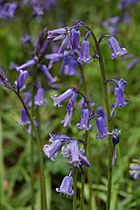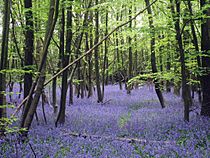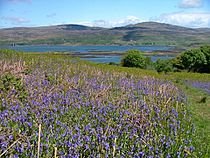Hyacinthoides non-scripta facts for kids
Quick facts for kids Hyacinthoides non-scripta |
|
|---|---|
 |
|
| Scientific classification | |
| Synonyms | |
|
The common bluebell (Hyacinthoides non-scripta) is a beautiful plant that grows from a bulb. It is a perennial plant, meaning it lives for more than two years. You can find it in western Europe, from Spain to the British Isles. Many people also grow it in their gardens.
In spring, the common bluebell produces lovely violet-blue flowers. These flowers hang down on one side of the stem and have a sweet smell. The petals curl back strongly. Bluebells are famous for creating stunning "bluebell woods," where the forest floor is covered in a carpet of blue flowers.
This plant is protected by law in the UK and some other places. Another similar plant, the Spanish bluebell (H. hispanica), has been brought to the British Isles. It can mix with the common bluebell to create new hybrid plants.
Contents
Understanding Bluebell Names
The common bluebell's scientific name is Hyacinthoides non-scripta. Carl Linnaeus first described it in 1753. He called it Hyacinthus non-scriptus. The name non-scriptus means "unlettered" or "unmarked." This was to tell it apart from a mythical flower in Greek mythology.
In the Greek myth, a flower grew from the blood of Prince Hyacinthus. The god Apollo, who loved Hyacinthus, cried tears that marked the flower's petals with "AIAI" (meaning "alas"). Linnaeus wanted to show that the bluebell didn't have these "letters."
Over time, the bluebell's scientific name changed a few times. It was called Scilla non-scripta and Endymion non-scriptus. Now, it is officially Hyacinthoides non-scripta. The name Hyacinthoides means "like a hyacinth."
Common Names for Bluebells
People use many common names for Hyacinthoides non-scripta. These include bluebell, common bluebell, English bluebell, and British bluebell. Some older names are wild hyacinth, wood bell, fairy flower, and bell bottle.
It's interesting that in Scotland, the name "bluebell" is often used for a different flower called the harebell (Campanula rotundifolia).
Bluebell Relatives
The common bluebell has close relatives. These include H. hispanica, H. paivae, and H. cedretorum. These plants are mostly found in the Iberian Peninsula (Spain and Portugal) and parts of North Africa.
What Bluebells Look Like
The common bluebell grows from a bulb buried in the ground. It has 3 to 6 long, thin leaves that grow from the base. These leaves are about 7 to 16 millimeters wide.
A tall stem, up to 50 centimeters high, holds 5 to 12 flowers. The top of the stem droops, and the flowers hang on one side. Each flower is about 14 to 20 millimeters long. The six petals (called tepals) are violet-blue and curl back strongly at their tips. The flowers have a strong, sweet smell. The pollen is cream-colored.
Bluebell bulbs have special roots that can pull the bulb deeper into the soil. This helps the plant find more moisture, especially in dry times. The seeds are black and grow on the soil surface.
Common vs. Spanish Bluebells
The common bluebell (H. non-scripta) is different from the Spanish bluebell (H. hispanica). Spanish bluebells have paler flowers that grow all around the stem, not just on one side. Their petals don't curl back as much, and they don't smell as strong. Also, the pollen of Spanish bluebells is blue, while common bluebells have cream-colored pollen.
These two types of bluebells can easily hybridize (mix) to create new plants. These hybrid plants are a mix of both parents.
Where Bluebells Grow and Live
Common bluebells are native to western Europe. You can find them in countries like Spain, Portugal, France, Belgium, the Netherlands, Ireland, and Great Britain. They have also spread to other places, including parts of North America.
The British Isles have the most bluebells. It's thought that 25% to 50% of all common bluebells in the world grow there! This is why "bluebell woods" are such a common and loved sight in the UK.
Bluebells usually grow in deciduous woodlands. They flower and grow their leaves early in spring before the trees get their full leaves. This allows them to get plenty of sunlight. They grow best in slightly acidic soils. Bluebells are often used as an indicator species. This means their presence can show that a woodland is very old (an ancient woodland). You can also find bluebells in hedgerows and, in western areas, in open fields near the coast.
Bluebell flowers are full of pollen and nectar. This attracts insects, especially bumblebees, which help pollinate the flowers. Bluebells also have a special relationship with tiny fungi in their roots. These fungi help the bluebells take up important nutrients like phosphorus from the soil.
Protecting Bluebells
The common bluebell (H. non-scripta) is not protected by major international laws. However, it is protected in the United Kingdom under the Wildlife and Countryside Act 1981.
This law makes it illegal for landowners to dig up wild common bluebells from their land to sell them. It is also a crime to remove the bulbs of wild bluebells. In 1998, the law became even stronger. It made it illegal to trade (buy or sell) any wild common bluebell bulbs or seeds. Breaking this law can lead to big fines, up to £5,000 for each bulb!
In France, bluebells are protected in many areas, especially at the edges of their natural range. In Wallonia, Belgium, bluebells are also a protected species.
How Bluebells Are Used
Bluebells are very popular garden plants. People often plant them under trees or in flower beds. They bloom at the same time as other spring flowers like hyacinths, daffodils, and some tulips. Bluebells can spread quickly by growing new bulbs and seeds. Sometimes, they might even need to be controlled if they spread too much.
Bluebells, especially their bulbs, are generally considered to be toxic. However, they also contain many special chemicals that could be useful. Scientists are studying some of these chemicals for possible medical uses, like fighting certain diseases. In the past, people used bluebell sap as an adhesive (glue).
Many people in the United Kingdom love the bluebell. In 2004, a plant charity held a survey to find a favorite flower for each county. They had to ban the bluebell from the vote because it was already the top choice in an earlier national poll! A picture of a bluebell is also used as the logo for the Botanical Society of Britain and Ireland.
In Culture
"In and Out the Dusting Bluebells" is a well-known children's playground song and dance.
See also
 In Spanish: Jacinto de los bosques para niños
In Spanish: Jacinto de los bosques para niños





